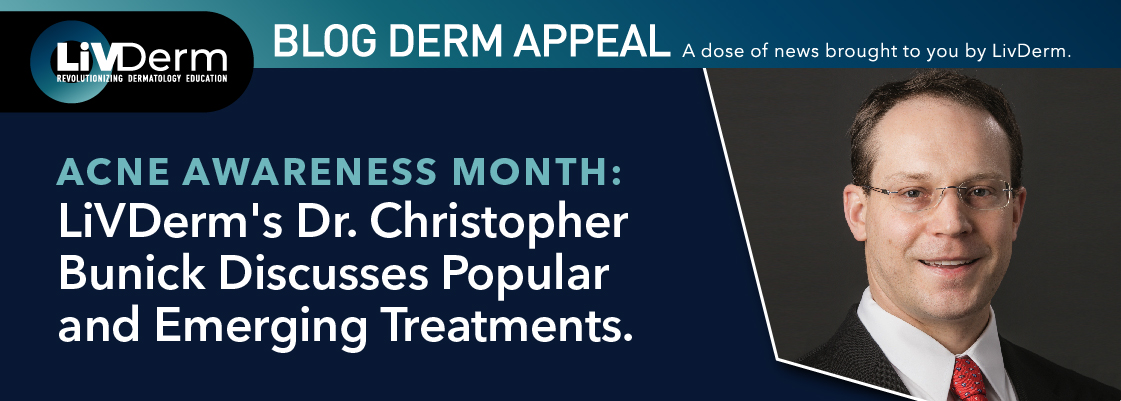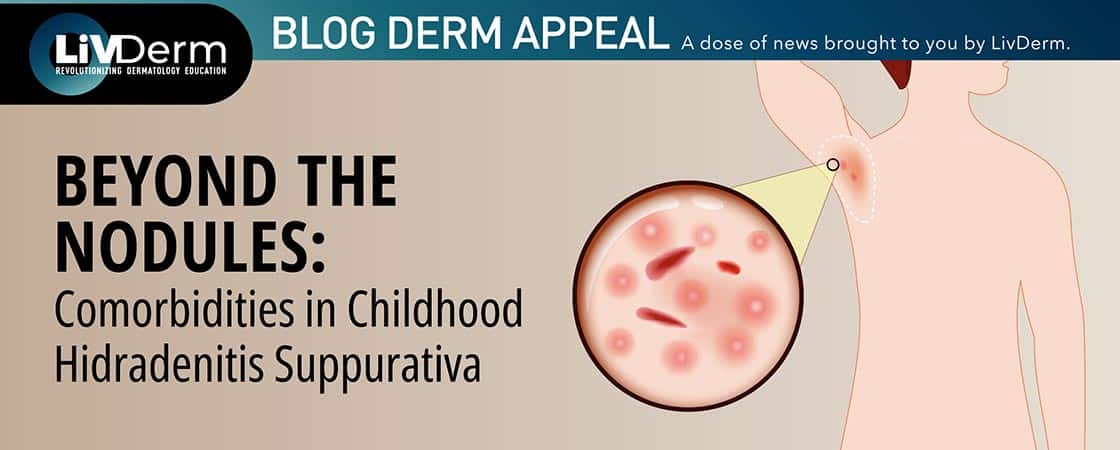Acne is the eighth most prevalent disease in the world, affecting 9.4% of people worldwide. It comes as no surprise, therefore, that the global market for acne medication is due to reach a massive $13.1 billion by 2027. In the United States alone, acne is the most common skin condition, with more than 50 million people affected each year. To recognize Acne Awareness Month, LiVDerm takes a look at the prevalence and causes of acne, and South Beach Symposium icon Christopher G. Bunick, MD, PhD, outlines the current and potential landscape of acne therapies.

What is acne?
Acne Vulgaris, more simply known as acne, is the presence of whiteheads, blackheads, and other types of pimples and lesions on the skin and typically occurs when the skin’s pores become clogged with oil, dead skin cells, or bacteria.
Although many people associate acne with teenagers, it can occur in people of all ages, with breakouts occurring not just on the face but also on the neck, shoulders, chest, and back. While mild acne can be quite common in many teenagers and adults, some patients experience extremely severe acne, which can heavily impact their self-confidence. This is one of the many reasons why finding ways of managing and treating this sometimes-afflictive skin condition is of utmost importance for dermatologists and other health care professionals.
Types of acne
Acne occurs when the skin’s hair follicles become blocked or clogged in some way. Follicle blockage can be the result of four main factors:
- Oil (sebum)
- Dead skin cells
- Bacteria
- Inflammation
The blocked follicles are known as comedones and can take many forms ranging from what is known as mild to severe acne.
- Blackheads – Comedones that are open at the surface of the skin and filled with excess oil and dead skin
- Whiteheads – Comedones that are closed at the surface of the skin
- Papules – Occurring when comedones become inflamed, forming small red bumps on the skin
- Pustules – Bumps that tend to be pus-filled and can sometimes resemble whiteheads but are characterized by a red ring around the bump
- Nodules – Inflamed bumps that remain underneath the skin’s surface
- Acne cysts – Large, pus-filled lesions that can resemble boils
Causes of acne
Although the chances of developing acne can be increased due to factors such as certain medications, stress levels, diet, or skin friction, acne can also occur due to hormonal changes, environmental factors, or even genetics. The causes and triggers of acne are numerous and at times ambiguous, making it hard to always pinpoint a specific causal factor. This is why in so many instances, it is vital for health care providers to have a comprehensive understanding of a patient’s background and lifestyle. This makes it easier for them to be able to properly develop a personalized treatment plan for their patients.
Ultimately, when it comes to acne, there is still a lot that remains unknown, and there is a continued need for more research into the many perplexities surrounding such a challenging skin condition.
Existing acne treatments
LiVDerm faculty member and South Beach Symposium (SBS) Planning Committee member Christopher G. Bunick, MD, PhD, associate professor of dermatology at Yale University School of Medicine, mentions that one of the most common complaints he receives from his patients with acne is that some of the treatments cause skin dryness. This is especially true for retinoid-based treatments. Many patients also report that some treatments do not offer enough relief from the inflammation caused by their acne. Dr. Bunick states that these issues can greatly affect patients’ propensity to stick to their treatment regime.
According to Dr. Bunick, there are a number of treatment options available to people with acne, some of which have only been recently approved by the Food and Drug Administration (FDA) after clinical trials demonstrated positive outcomes:
- Tazarotene lotion – For those desiring a retinoid option with minimal dryness, Dr. Bunick has seen success in the use of tazarotene in a lotion form. Tazarotene is well-known by dermatologists to dramatically improve acne.
- Topical dapsone – Topical dapsone works by slowing or stopping the growth of bacteria, therefore reducing blockage of the skin’s pores. It is also seen to cause less irritation and dryness compared to retinoid options.
- Clascoterone 1% cream – Clascoterone 1% cream, approved by the FDA in August 2020, works to inhibit sebum production. This first-in-class treatment has been well received by dermatologists and other health care professionals as it provides a long-awaited alternative to oral versions.
- Sarecycline – oral antibiotic – The oral antibiotic, sarecycline, is used as a once-daily medication to treat moderate-to-severe acne. Like topical dapsone, it also works to slow or stop the growth of certain bacteria on the skin. Dr. Bunick adds that this particular treatment shows a low potential of antibiotic resistance as well as being favorable to the gut and skin microbiome.
- IDP 126 topical gel – IDP 126 topical gel is a triple-combination, fixed-dose treatment for moderate-to-severe acne. It combines clindamycin phosphate 1.2%, benzoyl peroxide 3.1%, and adapalene 0.15%. Although still in an investigative stage and not yet approved by the FDA, the most recent results have shown a reduction of over 70% of acne lesions, making this look like a very promising form of acne treatment.
Emerging acne treatments
The high global prevalence of acne makes it a market that has an ongoing need for new and improved treatment methods, and there are always new ideas being introduced and tested. According to Dr. Bunick, there are two particular treatments for which he is most excited about the potential results:
- ASC40 – This acne treatment is currently in phase 2 clinical trials in China. It is a fatty acid synthase (FASN) inhibitor designed to reduce sebum production. The FASN is a key enzyme that regulates what is known as de novo lipogenesis, which is required for human sebum production.
- Acne vaccine – ORI-001 – The vaccine company Sanofi, through its acquisition of Origimm Biotechnology, will be moving into clinical trials for its ORI-001, a vaccine for acne. At this point, it is unknown whether a vaccination for acne will prove effective, but dermatologists are intrigued by this area of study.
Regardless of the type and dose of acne therapy chosen, Dr. Bunick recommends that providers review care plans every three or so months to make sure they are having the desired effect and that the patients are comfortable with and sticking to the treatment regime.
Key takeaway
As it stands, there is no one-size-fits-all acne treatment, as each patient with acne has different needs and preferences. Dr. Bunick encourages patients to communicate with their dermatologists and provide feedback so that they can help each other in finding the right balance in any treatment plan.
Sources:
- https://www.dermatologytimes.com/view/drug-watch-what-s-coming-in-acne-treatment-
- https://www.mayoclinic.org/diseases-conditions/acne/symptoms-causes/syc-20368047
- https://www.webmd.com/skin-problems-and-treatments/acne/ss/slideshow-acne-dictionary
- https://www.healio.com/news/dermatology/20200113/tazarotene-shows-favorable-riskbenefit-ratio-for-acne-vulgaris
- https://practicaldermatology.com/articles/2020-nov/tazarotene-lotion-for-acne
- https://medlineplus.gov/druginfo/meds/a616045.html
- https://www.dermatologytimes.com/view/clascoterone-cream-first-topical-to-target-androgen-receptors
- https://www.healio.com/news/dermatology/20220326/triple-combination-idp126-reduces-acne-lesions
- https://practicaldermatology.com/articles/2019-apr/efficacy-and-safety-of-newly-approved-oral-sarecycline-for-acne
- https://www.ascletis.com/single2/178.html
- https://seekingalpha.com/news/3775641-sanofi-to-acquire-origimm-biotech-to-treat-acne-with-vaccine-based-immunotherapy?gclid=Cj0KCQjwnNyUBhCZARIsAI9AYlFJOBhj9dVANbm71hDKVTDgL7Da_vhfgxNqYYR-vQrm9nO8OrxYtS8aAgruEALw_wcB&internal_promotion=true&utm_campaign=14049528666&utm_medium=cpc&utm_source=google&utm_term=137460309828%5Edsa-1455881688143%5E%5E555764444356%5E%5E%5Eg
- https://pubmed.ncbi.nlm.nih.gov/25597339/#:~:text=Acne%20is%20estimated%20to%20affect,severe%20forms%20of%20the%20disease.
- https://www.gminsights.com/industry-analysis/acne-medication-market#:~:text=Acne%20Medication%20Market%20size%20was,6%25%20between%202021%20and%202027.&text=Rising%20prevalence%20of%20acne%20ailments,the%20acne%20medication%20market%20growth.

















